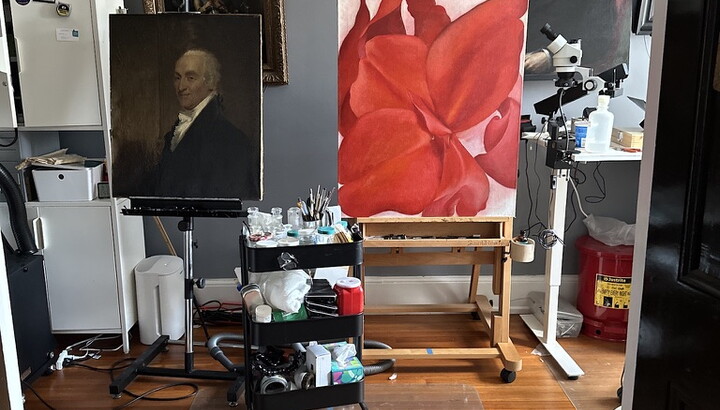The Carter Blog
Carter ARTicles
Arthur Dove: Illuminating the unseen
Jan 07, 2022
One of my favorite aspects of my job as a paper conservator is the time I get to spend looking at works of art on paper up close and personal. One of the reasons we look closely is to identify materials and processes the artist may have used while creating the artwork. Recently, I have had the opportunity to research Arthur Dove (1880–1946), one of the artists in the Carter’s collection. The Carter holds works from across Dove’s career, from one of his first paintings, The Lobster (1908), to a set of 47 paintings on paper done at the end of his life, roughly between 1940 and 1946. I love that the Museum has work that spans Dove’s lifetime, because it is interesting to see how his style evolved over time.
Arthur Dove
Slide Controls
Slides
There are many tools and analytical techniques conservators use when we investigate an object. Today, I want to highlight the technique of multispectral imaging, which I used when researching Dove’s materials and techniques. The term “multispectral imaging” means that I am capturing digital images of each work with a camera using different parts of the electromagnetic (EM) spectrum. The EM spectrum is a range of all the types of EM radiation in the universe, including radio waves, microwaves, infrared, visible light, ultraviolet, X-rays, and gamma rays.
Multispectral imaging uses three distinct areas of the EM spectrum: visible, ultraviolet, and infrared. The response of the object in each area highlights different information about the materials and the processes used to create the artwork.
The visible portion of the spectrum is the one that you are already familiar with as this is what we can see with our eyes. The ultraviolet and the infrared portions sit on either side of the visible.
The ultraviolet portion of the spectrum consists of shorter wavelengths that can tell us specific information about the materials used. There are two types of images that we can capture. Reflected ultraviolet can give us information about the surface of the object, like whether the artist used a varnish, and sometimes can indicate the layered structure of the object.
In the image above, you can see that on the left-hand side Dove painted over the black outline with a layer of blue-green paint. We can see this because of how the layer is obscuring the left side of the figure in the reflected ultraviolet image, indicating the green layer is on top of the figure underneath.
In the image below, at right, which shows ultraviolet-induced visible fluorescence, specific pigments fluoresce with characteristic colors that can aid in material identification. For example, in this image, you can see that the white area is fluorescing green under ultraviolet radiation. This type and color of fluorescence is a characteristic reaction of the element zinc. This is helpful to us because zinc is only found in one type of white pigment, zinc white, so this points to the specific paint Dove used for this composition.
The infrared portion of the spectrum consists of longer wavelengths that can penetrate the materials to a greater extent than ultraviolet and visible. For this reason, this technique is helpful in identifying any underdrawings that might exist below the top layer of paint. You can see in the reflected infrared image below on the right that Dove decided to paint over an earlier iteration of his work to create the final work, shown below on the left. I like this technique because it gives you a glimpse into the decision-making process of the artist, which can add to our overall understanding of the object.
Observing closely an artist’s choice of materials and artistic process helps us see the evolution of an object from conception to final composition. There is so much more to see than meets the eye, and multispectral imaging helps us see it!










